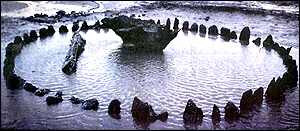
 picture copyright bbc. picture copyright bbc.
|
Seahenge, the ring of Oak timbers with a centre altar of an upturned Oak stump was recently uncovered on the beach at Holme-next-the-sea Norfolk , Tests carried out on the centrepiece, a massive oak stump with the roots exposed, have revealed that it was felled sometime between April and June 2050 BC. The Oak stump was also found to have pieces of rope attached to the buried end made of woven Honeysuckle, this rope was probably used to drag the stump into place and left attached when the stump base was buried. Archaeologists often find items buried upside down at Bronze age sites and it's certain that the central stump was buried upside down for a symbolic reason. The 55 Oak trees in the ring around the central stump are believed to have been felled the following Spring, 2049 BC.
It is believed that these timber circles were used by our prehistoric ancestors in a practise known as excarnation - exposing the dead to the elements, birds and wild animals. The belief being that allowing the flesh to rot from the bone in the open air would enable the person's spirit to be liberated. The outer ring was built of split young oak trunks and were set up in the manner of a stockade, a small opening just large enough for a person to slip through was allowed by using a section of a tree which was forked, the outer ring was probabley 8 feet tall.
The lay out and sheer effort involved in moving the trees to this site all point to this being an extremely important ceremonial/religous site to our Bronze Age ancestors and many archeaologists consider this the Bronze Age discovery of the decade.
Latest News on Seahenge
|
